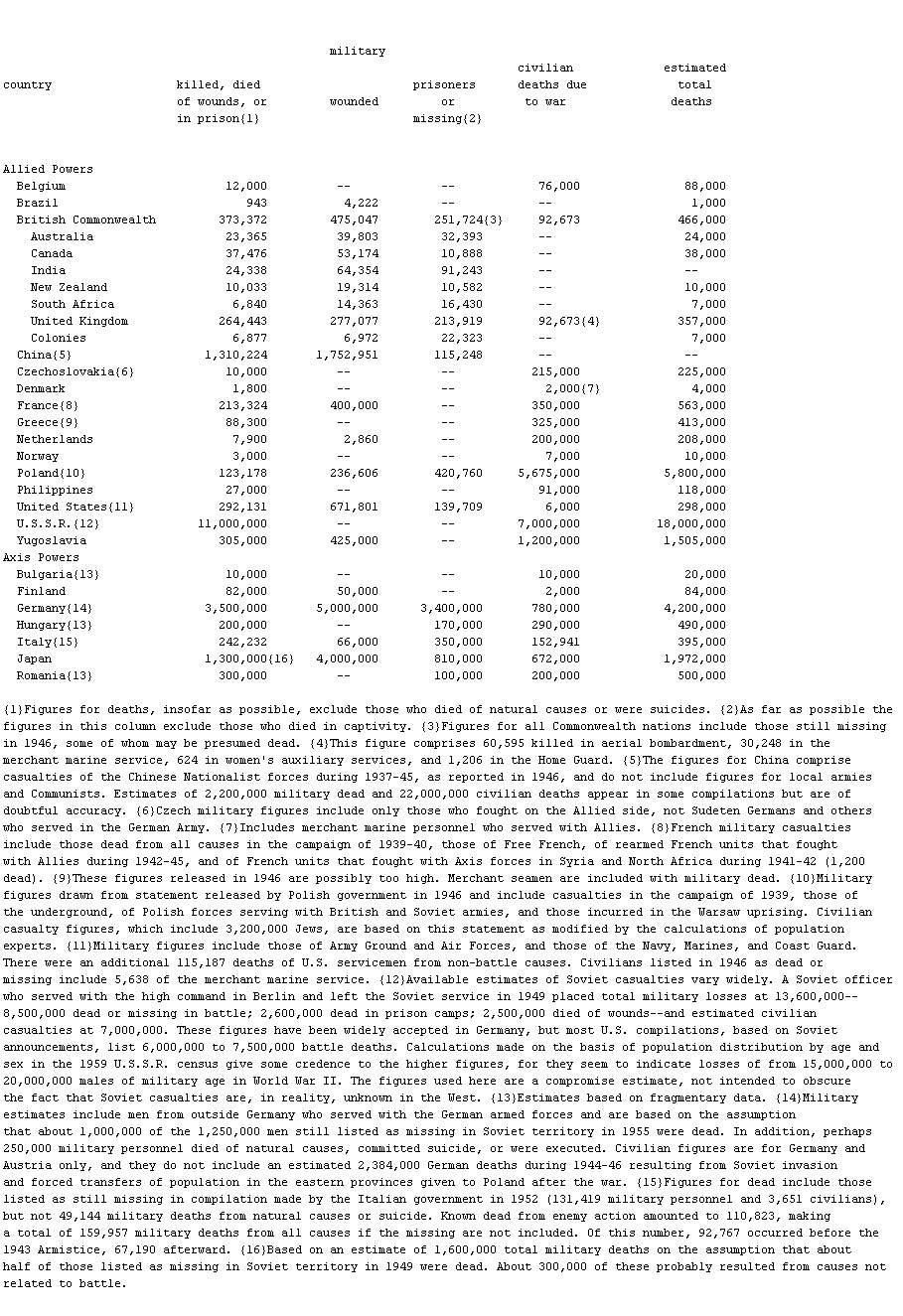- World War II Casualties, Table
-
▪ Tablemilitarycivilian estimatedcountry killed, died prisoners deaths due totalof wounds, or wounded or to war deathsin prison{1} missing{2}Allied PowersBelgium 12,000 — — 76,000 88,000Brazil 943 4,222 — — 1,000British Commonwealth 373,372 475,047 251,724{3} 92,673 466,000Australia 23,365 39,803 32,393 — 24,000Canada 37,476 53,174 10,888 — 38,000India 24,338 64,354 91,243 — —New Zealand 10,033 19,314 10,582 — 10,000South Africa 6,840 14,363 16,430 — 7,000United Kingdom 264,443 277,077 213,919 92,673{4} 357,000Colonies 6,877 6,972 22,323 — 7,000China{5} 1,310,224 1,752,951 115,248 — —Czechoslovakia{6} 10,000 — — 215,000 225,000Denmark 1,800 — — 2,000{7} 4,000France{8} 213,324 400,000 — 350,000 563,000Greece{9} 88,300 — — 325,000 413,000Netherlands 7,900 2,860 — 200,000 208,000Norway 3,000 — — 7,000 10,000Poland{10} 123,178 236,606 420,760 5,675,000 5,800,000Philippines 27,000 — — 91,000 118,000United States{11} 292,131 671,801 139,709 6,000 298,000U.S.S.R.{12} 11,000,000 — — 7,000,000 18,000,000Yugoslavia 305,000 425,000 — 1,200,000 1,505,000Axis PowersBulgaria{13} 10,000 — — 10,000 20,000Finland 82,000 50,000 — 2,000 84,000Germany{14} 3,500,000 5,000,000 3,400,000 780,000 4,200,000Hungary{13} 200,000 — 170,000 290,000 490,000Italy{15} 242,232 66,000 350,000 152,941 395,000Japan 1,300,000{16} 4,000,000 810,000 672,000 1,972,000Romania{13} 300,000 — 100,000 200,000 500,000{1}Figures for deaths, insofar as possible, exclude those who died of natural causes or were suicides. {2}As far as possible thefigures in this column exclude those who died in captivity. {3}Figures for all Commonwealth nations include those still missingin 1946, some of whom may be presumed dead. {4}This figure comprises 60,595 killed in aerial bombardment, 30,248 in themerchant marine service, 624 in women's auxiliary services, and 1,206 in the Home Guard. {5}The figures for China comprisecasualties of the Chinese Nationalist forces during 1937-45, as reported in 1946, and do not include figures for local armiesand Communists. Estimates of 2,200,000 military dead and 22,000,000 civilian deaths appear in some compilations but are ofdoubtful accuracy. {6}Czech military figures include only those who fought on the Allied side, not Sudeten Germans and otherswho served in the German Army. {7}Includes merchant marine personnel who served with Allies. {8}French military casualtiesinclude those dead from all causes in the campaign of 1939-40, those of Free French, of rearmed French units that foughtwith Allies during 1942-45, and of French units that fought with Axis forces in Syria and North Africa during 1941-42 (1,200dead). {9}These figures released in 1946 are possibly too high. Merchant seamen are included with military dead. {10}Militaryfigures drawn from statement released by Polish government in 1946 and include casualties in the campaign of 1939, those ofthe underground, of Polish forces serving with British and Soviet armies, and those incurred in the Warsaw uprising. Civiliancasualty figures, which include 3,200,000 Jews, are based on this statement as modified by the calculations of populationexperts. {11}Military figures include those of Army Ground and Air Forces, and those of the Navy, Marines, and Coast Guard.There were an additional 115,187 deaths of U.S. servicemen from non-battle causes. Civilians listed in 1946 as dead ormissing include 5,638 of the merchant marine service. {12}Available estimates of Soviet casualties vary widely. A Soviet officerwho served with the high command in Berlin and left the Soviet service in 1949 placed total military losses at 13,600,000—8,500,000 dead or missing in battle; 2,600,000 dead in prison camps; 2,500,000 died of wounds—and estimated civiliancasualties at 7,000,000. These figures have been widely accepted in Germany, but most U.S. compilations, based on Sovietannouncements, list 6,000,000 to 7,500,000 battle deaths. Calculations made on the basis of population distribution by age andsex in the 1959 U.S.S.R. census give some credence to the higher figures, for they seem to indicate losses of from 15,000,000 to20,000,000 males of military age in World War II. The figures used here are a compromise estimate, not intended to obscurethe fact that Soviet casualties are, in reality, unknown in the West. {13}Estimates based on fragmentary data. {14}Militaryestimates include men from outside Germany who served with the German armed forces and are based on the assumptionthat about 1,000,000 of the 1,250,000 men still listed as missing in Soviet territory in 1955 were dead. In addition, perhaps250,000 military personnel died of natural causes, committed suicide, or were executed. Civilian figures are for Germany andAustria only, and they do not include an estimated 2,384,000 German deaths during 1944-46 resulting from Soviet invasionand forced transfers of population in the eastern provinces given to Poland after the war. {15}Figures for dead include thoselisted as still missing in compilation made by the Italian government in 1952 (131,419 military personnel and 3,651 civilians),but not 49,144 military deaths from natural causes or suicide. Known dead from enemy action amounted to 110,823, makinga total of 159,957 military deaths from all causes if the missing are not included. Of this number, 92,767 occurred before the1943 Armistice, 67,190 afterward. {16}Based on an estimate of 1,600,000 total military deaths on the assumption that abouthalf of those listed as missing in Soviet territory in 1949 were dead. About 300,000 of these probably resulted from causes notrelated to battle.

* * *
Universalium. 2010.
